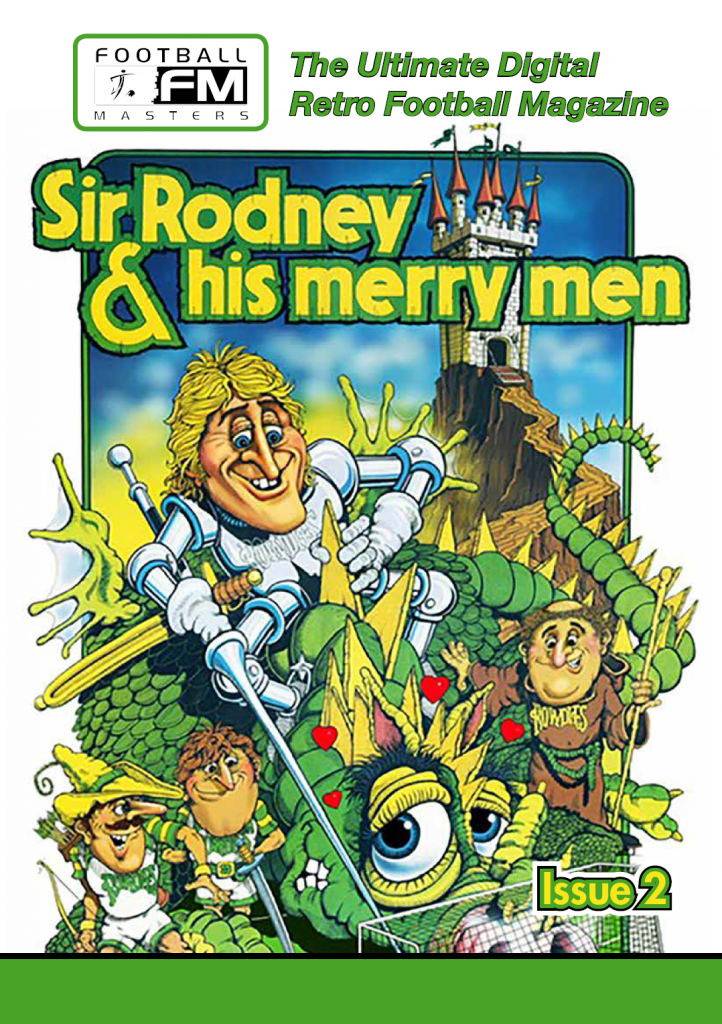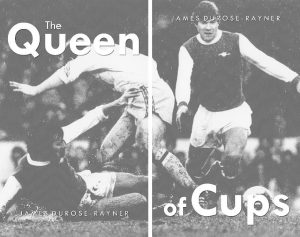Book Review – Fast Forward: The Autobiography: The Hard Road to Football Success by Andrew Cole
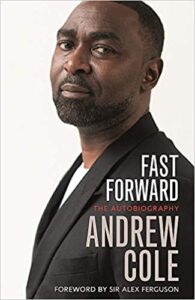 When it comes to football, there are some players who remain, either through sporting posterity or perhaps through wilful self-promotion, front and centre in fans’ consciousness and other who fade, rightly or wrongly, into the background. For many Manchester United fans, I imagine Andrew Cole is forever etched in their memories, part of the historic 1999 treble-winning squad, but for all of that success, for neutral fans he is probably not as well-remembered as other players of that generation, team-mates like Scholes, Giggs and Keane, and even his strike partner Dwight Yorke. Yet, he remains the third-highest goalscorer, behind only Alan Shearer and Wayne Rooney, in Premier League history, with 187 goals, as well as being joint-top goalscorer with 34 goals in a 42-game Premier League season, and the first player to top both the Premier League goalscoring and assists charts in the same season. Add to this, a clean sweep of trophies, including five Premier League titles, two FA Cups, two Charity Shields, a League Cup and, of course, that iconic Champions League, as well as PFA Young Player of the year.
When it comes to football, there are some players who remain, either through sporting posterity or perhaps through wilful self-promotion, front and centre in fans’ consciousness and other who fade, rightly or wrongly, into the background. For many Manchester United fans, I imagine Andrew Cole is forever etched in their memories, part of the historic 1999 treble-winning squad, but for all of that success, for neutral fans he is probably not as well-remembered as other players of that generation, team-mates like Scholes, Giggs and Keane, and even his strike partner Dwight Yorke. Yet, he remains the third-highest goalscorer, behind only Alan Shearer and Wayne Rooney, in Premier League history, with 187 goals, as well as being joint-top goalscorer with 34 goals in a 42-game Premier League season, and the first player to top both the Premier League goalscoring and assists charts in the same season. Add to this, a clean sweep of trophies, including five Premier League titles, two FA Cups, two Charity Shields, a League Cup and, of course, that iconic Champions League, as well as PFA Young Player of the year.
Whilst Andrew Cole’s records therefore clearly place him amongst the Premier League’s elites and deserve acclaim, he is not one for the fame and spotlight. A more introspective and private footballer, not one of the game’s flamboyant characters or over-the-top personalities, he explains in his autobiography how this was often interpreted as aloofness and arrogance, and this perhaps has contributed to him not always being centre-stage in discussions of the Premier League and footballing past. He is simply just not your flashy showman, hogging the limelight, not the open book of some of his peers, so it is fascinating to literally now open that book and get to know more about this often misunderstood and more private of men in his autobiography, Fast Forward.
In true autobiography fashion, the book takes the reader on a chronological journey of Cole’s life, giving an eye-opening portrait of a self-proclaimed naughty, difficult child. There is a real sense of the development of his character and personality in his younger years, flaws and all. And it is clear that while Cole was rebellious, stubborn, defiant, he was also determined, ambitious and steadfast – characteristics that would go on to shape his career, both for better and worse. For me, his reflections back on his life as an adolescent teenager at Lilleshall were unsettling and hopefully a far cry from experiences of young footballers today, but they were simply part of the culture and sport in that period.
Though he covers, too, his experiences at Arsenal and Newcastle, it is really with Man United that Cole is synonymous, and it is obvious in his reflections on this period and club in particular that this was the defining point not only in Cole’s career but in the shaping of his footballing education and beliefs. Everything that precedes and follows it is viewed in comparison; for this was the Manchester United under Alex Ferguson at the turn of the millennium that led the way in football on many fronts. His experiences that followed at Blackburn are only made all the more unfavourable given his United schooling, and the seven years that succeeded his six-year spell at the Theatre of Dreams are largely limited to brief summations, often of the difficult experiences and relationships that blighted his later years in football. Several big names – and some of those media-savvy personalities – don’t come out particularly favourably, but perhaps one of the more divisive figures in football, Roy Keane, emerges wholly agreeably – which may not go down well with the man himself, but serves to remind readers that we only see one side of these footballers. With Cole’s frankness about his professional relationships, and his headstrong approach, there is a sense of wondering whether this affected his career, both domestically and internationally, as accounts of his limited England days are also included.
When Cole hung up his boots in 2008, the fact that he is not one of those players who courted the media would have seemed to allow him to retire in relative peace, but his biggest challenge of his life then faced him off the pitch as he suffered kidney failure, leading to a transplant in 2017. Oftentimes, footballers can come to be seen as invincible, but Cole’s horrific health struggles, which he details frankly, are a reminder that footballers are human and vulnerable too.
As someone happy to step away from the spotlight after football, Andrew Cole in many ways has become something of the forgotten man of English football when his record should arguably guarantee his legacy, but his autobiography throws up a really interesting question about how personality and attitude are judged alongside ability. For me, what I remember of Cole is his goalscoring instinct, and his uncanny partnership with Dwight Yorke – in many ways, they were the archetypal strike partnership – but what this book makes clear is that football, and particularly legacy, is not only about what happens on the pitch, it is also, perhaps now more so than ever, shaped by the narratives and personalities that are constructed beyond it. Cole may not be the most gregarious or colourful of characters, he is more nuanced and complex, more human perhaps. He suffers and struggles like all of us, and his health battles make that all the more emphatic. But whatever his character, his personality, judged on the pitch, on his records, his trophies, Andrew Cole deserves his place alongside Shearer, Rooney et al, and that’s something that shouldn’t be forgotten.
Jade Craddock
(Hodder & Stoughton. November 2020. Hardback 336 pages)
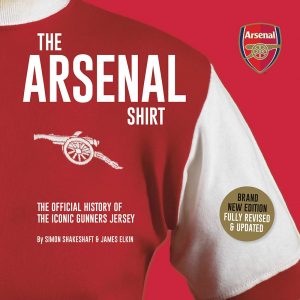 This is the second edition of this ‘coffee table book’ with the original edition released in November 2014 and titled The Arsenal Shirt: The History of the Iconic Gunners Jersey Told Through an Extraordinary Collection of Match Worn Shirts. As with then, the authors are James Elkin and Simon Shakeshaft, with much of the collection referenced in the first book seen and added to in this second edition, belonging to co-author James Elkin.
This is the second edition of this ‘coffee table book’ with the original edition released in November 2014 and titled The Arsenal Shirt: The History of the Iconic Gunners Jersey Told Through an Extraordinary Collection of Match Worn Shirts. As with then, the authors are James Elkin and Simon Shakeshaft, with much of the collection referenced in the first book seen and added to in this second edition, belonging to co-author James Elkin.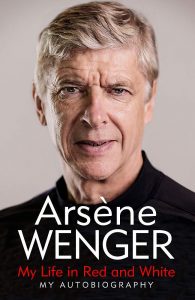 For Arsenal fans and football scholars, the release of Arsene Wenger’s first ever autobiography, My Life in Red and White, signalled a much-anticipated event, a chance to hear from the man who stamped his mark on Arsenal and the Premier League, a man who divided opinion but unquestionably brought success, a man who was notoriously private and enigmatic away from the pitch, but who wore his heart on his sleeve during matches. But those hoping for a no-holds-barred confessional, with revelations about his players, opponents and fellow managers will be disappointed. Wenger is nothing if not a principled man – as Arsenal fans will attest, either positively citing his loyalty to the club or conversely bemoaning his stubbornness to see out his contract – so it should be no real surprise that instead of a sensationalised tell-all, the autobiography is as measured, moderate and considered as the man himself, with astute observations on his own childhood and entry into football and thoughtful reflections on management and the game.
For Arsenal fans and football scholars, the release of Arsene Wenger’s first ever autobiography, My Life in Red and White, signalled a much-anticipated event, a chance to hear from the man who stamped his mark on Arsenal and the Premier League, a man who divided opinion but unquestionably brought success, a man who was notoriously private and enigmatic away from the pitch, but who wore his heart on his sleeve during matches. But those hoping for a no-holds-barred confessional, with revelations about his players, opponents and fellow managers will be disappointed. Wenger is nothing if not a principled man – as Arsenal fans will attest, either positively citing his loyalty to the club or conversely bemoaning his stubbornness to see out his contract – so it should be no real surprise that instead of a sensationalised tell-all, the autobiography is as measured, moderate and considered as the man himself, with astute observations on his own childhood and entry into football and thoughtful reflections on management and the game.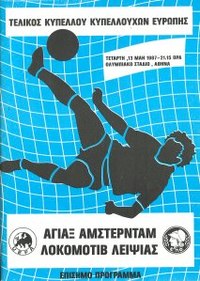
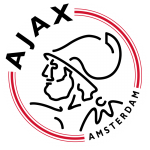 Ajax revive their traditions
Ajax revive their traditions Their opponents were 1. FC Lokomotive Leipzig, a solid if unimaginative team from the German Democratic Republic (East Germany) with an excellent goalkeeper in René Müller. They made unspectacular but solid progress, beating Glentoran FC of Northern Ireland 3-1 and, in the Second Round, raised a few eyebrows by eliminating SK Rapid Wien after extra-time. The draw gave them FC Sion in the quarter-finals, and they beat the Swiss 2-0. A curious semi-final against Girondins de Bordeaux produced two 1-0 away wins and victory for Lokomotiv in a penalty shoot-out.
Their opponents were 1. FC Lokomotive Leipzig, a solid if unimaginative team from the German Democratic Republic (East Germany) with an excellent goalkeeper in René Müller. They made unspectacular but solid progress, beating Glentoran FC of Northern Ireland 3-1 and, in the Second Round, raised a few eyebrows by eliminating SK Rapid Wien after extra-time. The draw gave them FC Sion in the quarter-finals, and they beat the Swiss 2-0. A curious semi-final against Girondins de Bordeaux produced two 1-0 away wins and victory for Lokomotiv in a penalty shoot-out.

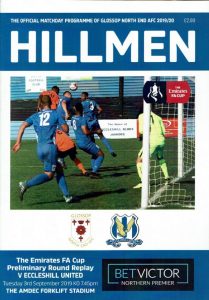

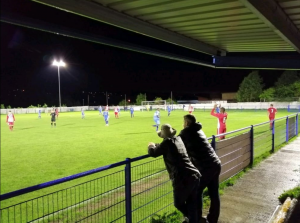
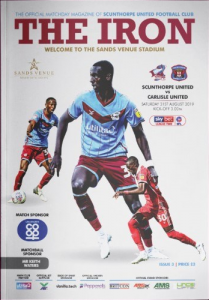


 A career in football is hard enough to achieve on your own, but when you are from a football family, then the pressure must be immense. For Clive Allen, that must have been monumental, with his father, Les, part of the Tottenham Hotspur’s team that did the ‘double’ in winning the First Division title and FA Cup in 1960/61, and a younger brother, Bradley and two cousins, Martin and Paul, who also went on to have professional careers in the game.
A career in football is hard enough to achieve on your own, but when you are from a football family, then the pressure must be immense. For Clive Allen, that must have been monumental, with his father, Les, part of the Tottenham Hotspur’s team that did the ‘double’ in winning the First Division title and FA Cup in 1960/61, and a younger brother, Bradley and two cousins, Martin and Paul, who also went on to have professional careers in the game. This book was originally released in Germany in 2018 with the title, Weltmeister ohne talent: Mein leben, meine karriere (World champion without talent: My life, my career) and was released in the UK a year later by deCoubertin Books after translation by Ceylan Hussein. The UK version has a different cover and in fact a different title, Per Mertesacker – BFG, Big Friendly German, My Autobiography. Of course, this is a play on the title of Roald Dahl’s children’s favourite, The BFG (Big Friendly Giant) and a nod to the Arsenal faithful who nicknamed Mertesacker, Big F***ing German, during his playing career at the Emirates.
This book was originally released in Germany in 2018 with the title, Weltmeister ohne talent: Mein leben, meine karriere (World champion without talent: My life, my career) and was released in the UK a year later by deCoubertin Books after translation by Ceylan Hussein. The UK version has a different cover and in fact a different title, Per Mertesacker – BFG, Big Friendly German, My Autobiography. Of course, this is a play on the title of Roald Dahl’s children’s favourite, The BFG (Big Friendly Giant) and a nod to the Arsenal faithful who nicknamed Mertesacker, Big F***ing German, during his playing career at the Emirates. There follows the four biggest chapters of the book which are organised into, Pattensen, which looks at his childhood, his parents and his pride of his hometown and his roots, Bundesliga, covering his playing career at Hannover 96 and Werder Bremen, Premier League, as Mertesacker moved to Arsenal in 2011 and Welmeister, focusing on his time with the German national team, culminating in winning a World Cup winners medal in 2014. The fifth chapter, The Beginning, neatly brings the reader up to date with Mertesacker in post at the Arsenal Academy and a reflective piece on his time as a young player, compared to that of the Academy players of today.
There follows the four biggest chapters of the book which are organised into, Pattensen, which looks at his childhood, his parents and his pride of his hometown and his roots, Bundesliga, covering his playing career at Hannover 96 and Werder Bremen, Premier League, as Mertesacker moved to Arsenal in 2011 and Welmeister, focusing on his time with the German national team, culminating in winning a World Cup winners medal in 2014. The fifth chapter, The Beginning, neatly brings the reader up to date with Mertesacker in post at the Arsenal Academy and a reflective piece on his time as a young player, compared to that of the Academy players of today.